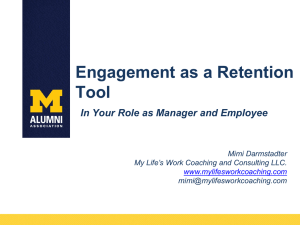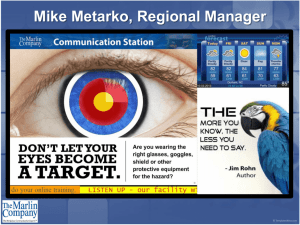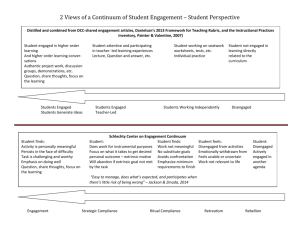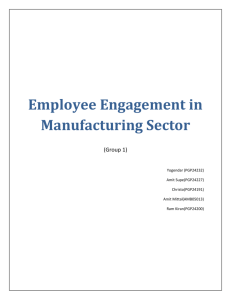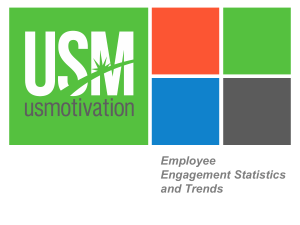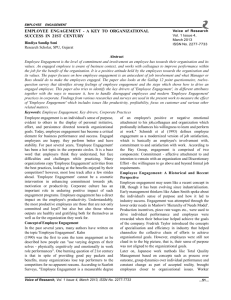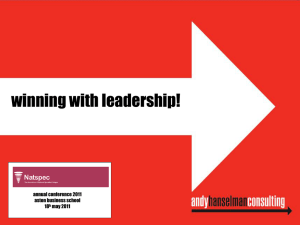Employee Engagement WPS05 SIES College of Management Studies
advertisement
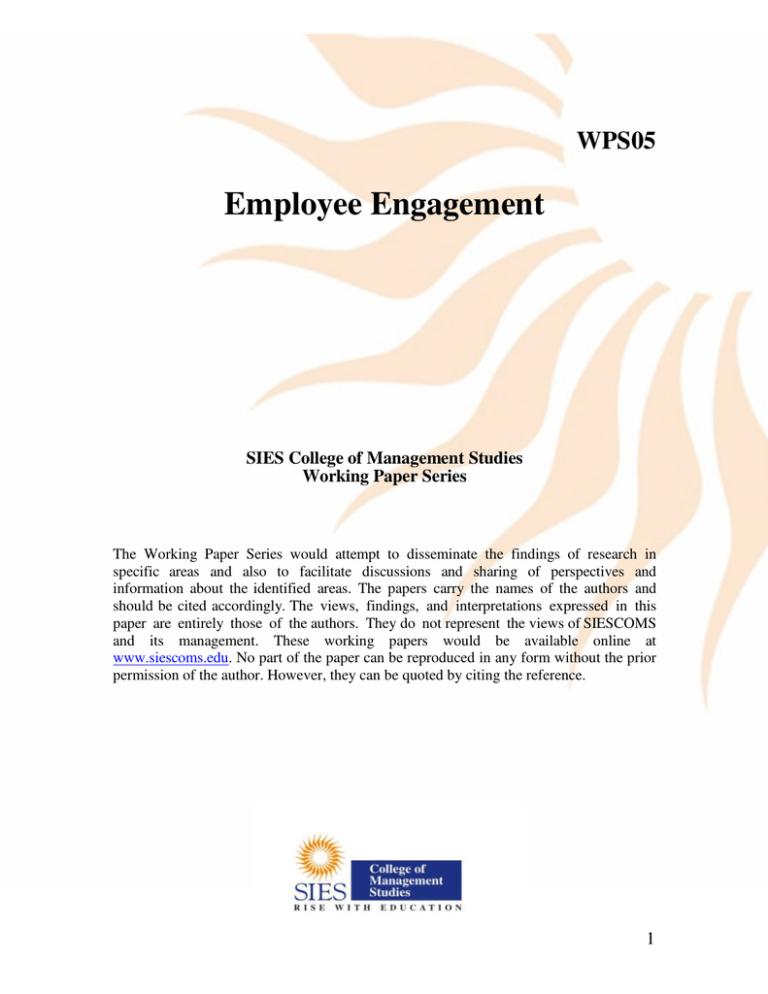
WPS05
Employee Engagement
SIES College of Management Studies
Working Paper Series
The Working Paper Series would attempt to disseminate the findings of research in
specific areas and also to facilitate discussions and sharing of perspectives and
information about the identified areas. The papers carry the names of the authors and
should be cited accordingly. The views, findings, and interpretations expressed in this
paper are entirely those of the authors. They do not represent the views of SIESCOMS
and its management. These working papers would be available online at
www.siescoms.edu. No part of the paper can be reproduced in any form without the prior
permission of the author. However, they can be quoted by citing the reference.
1
Working Paper 05/07
Employee Engagement
Nitin Vazirani
Dean in OB and HR
SIES College of Management Studies
Nerul
nitin@siescoms.edu
Abstract
Employee engagement is the level of commitment and involvement an employee has
towards their organization and its values. An engaged employee is aware of business
context, and works with colleagues to improve performance within the job for the benefit
of the organization. It is a positive attitude held by the employees towards the
organization and its values. The paper focuses on how employee engagement is an
antecedent of job involvement and what should company do to make the employees
engaged. The paper also looks at the Gallup 12 point questionnaire, twelve-question
survey that identifies strong feelings of employee engagement and the steps which shows
how to drive an engaged employee.
2
Introduction
Engagement at work was conceptualized by Kahn, (1990) as the ‘harnessing of
organizational members’ selves to their work roles. In engagement, people employ and
express themselves physically, cognitively, and emotionally during role performances.
The second related construct to engagement in organizational behavior is the notion of
flow advanced by Csikszentmihalyi (1975, 1990). Csikzentmihalyi (1975) defines flow as
the ‘holistic sensation’ that, people feel when they act with total involvement. Flow is
the state in which there is little distinction between the self and environment. When
individuals are in Flow State little conscious control is necessary for their actions.
Employee engagement is the thus the level of commitment and involvement an employee
has towards their organization and its values. An engaged employee is aware of business
context, and works with colleagues to improve performance within the job for the benefit
of the organization. The organization must work to develop and nurture engagement,
which requires a two-way relationship between employer and employee.’ Thus Employee
engagement is a barometer that determines the association of a person with the
organization
Engagement is most closely associated with the existing construction of job involvement
(Brown 1996) and flow (Csikszentmihalyi, 1990). Job involvement is defined as ‘the
degree to which the job situation is central to the person and his or her identity (Lawler &
Hall, 1970). Kanungo (1982) maintained that job involvement is a ‘Cognitive or belief
state of Psychological identification. Job involvement is thought to depend on both need
saliency and the potential of a job to satisfy these needs. Thus job involvement results
form a cognitive judgment about the needs satisfying abilities of the job. Jobs in this view
are tied to one’s self image. Engagement differs from job in as it is concerned more with
how the individual employees his/her self during the performance of his / her job.
Furthermore engagement entails the active use of emotions. Finally engagement may be
thought of as an antecedent to job involvement in that individuals who experience deep
engagement in their roles should come to identify with their jobs.
3
When Kahn talked about employee engagement he has given important to all three
aspects physically, cognitively and emotionally. Whereas in job satisfaction importance
has been more given to cognitive side.
HR practitioners believe that the engagement challenge has a lot to do with how
employee feels about the about work experience and how he or she is treated in the
organization. It has a lot to do with emotions which are fundamentally related to drive
bottom line success in a company. There will always be people who never give their best
efforts no matter how hard HR and line managers try to engage them. “But for the most
part employees want to commit to companies because doing so satisfies a powerful and a
basic need in connect with and contribute to something significant”.
Aspects of Employee Engagement
Three basic aspects of employee engagement according to the global studies are:•
The employees and their own unique psychological make up and experience
•
The employers and their ability to create the conditions that promote employee
engagement
•
Interaction between employees at all levels.
Thus it is largely the organization’s responsibility to create an enviro nment and culture
conducive to this partnership, and a win-win equation.
Categories of Employee Engagement
According to the Gallup the Consulting organization there are there are different types of
people:Engaged--"Engaged" employees are builders. They want to know the desired
expectations for their role so they can meet and exceed them. They're naturally curious
about their company and their place in it. They perform at consistently high levels. They
want to use their talents and strengths at work every day. They work with passion and
they drive innovation and move their organization forward
4
Not Engaged---Not-engaged employees tend to concentrate on tasks rather than the goals
and outcomes they are expected to accomplish. They want to be told what to do just so
they can do it and say they have finished. They focus on accomplishing tasks vs.
achieving an outcome. Employees who are not-engaged tend to feel their contributions
are being overlooked, and their potential is not being tapped. They often feel this way
because they don't have productive relationships with their managers or with their
coworkers.
Actively Disengaged--The "actively disengaged" employees are the "cave dwellers."
They're "Consistentlyagainst Virtually Everything." They're not just nuhappy at work;
they're busy acting out their unhappiness.They sow seeds of negativity at every
opportunity. Every day, actively disengaged workers undermine what their engaged
coworkers accomplish. As workers increasingly rely on each other to generate products
and services, the problems and tensions that are fostered by actively disengaged workers
can cause great damage to an organization's functioning.
Importance of Engagement
Engagement is important for managers to cultivate given that disengagement or
alienation is central to the problem of workers’ lack of commitment and motivation
(Aktouf). Meaningless work is often associated with apathy and detachment from ones
works (Thomas and Velthouse). In such conditions, individuals are thought to be
estranged from their selves (Seeman, 1972) .Other Research using a different resource of
engagement (involvement and enthusiasm) has linked it to such variables as employee
turnover, customer satisfaction – loyalty, safety and to a lesser degree, productivity and
profitability criteria (Harter, Schnidt & Hayes, 2002).
5
An organization’s capacity to manage employee engagement is closely related to its
ability to achieve high performance levels and superior business results. Some of the
advantages of Engaged employees are
•
Engaged employees will stay with the company, be an advocate of the company
and its products and services, and contribute to bottom line business success.
•
They will normally perform better and are more motivated.
•
There is a significant link between employee engagement and profitability.
•
They form an emotional connection with the company. This impacts their attitude
towards the company’s clients, and thereby improves customer satisfaction and
service levels
•
It builds passion, commitment and alignment with the organization’s strategies
and goals
•
Increases employees’ trust in the organization
•
Creates a sense of loyalty in a competitive environment
•
Provides a high-energy working environment
•
Boosts business growth
•
Makes the employees effective brand ambassadors for the company
A highly engaged employee will consistently deliver beyond expectations. In the
workplace research on employee engagement (Harter, Schmidt & Hayes, 2002) have
repeatedly asked employees ‘whether they have the opportunity to do what they do best
everyday’. While one in five employees strongly agree with this statement. Those work
units scoring higher on this perception have substantially higher performance.
Thus employee engagement is critical to any organization that seeks to retain valued
employees. The Watson Wyatt consulting companies has been proved that there is an
intrinsic link between employee engagement, customer loyalty, and profitability. As
organizations globalize and become more dependent on technology in a virtual working
environment, there is a greater need to connect and engage with employees to provide
them with an organizational ‘identity.’
6
Factors Leading to Employee EngagementStudies have shown that there are some critical factors which lead to Employee
engagement. Some of them identified are
Career Development- Opportunities
for personal development
Career Development – Effective
Management of talent
Leadership- Clarity of company
values
Feeling
valued
&
Involved
Leadership – Respectful treatment
of employees
Leadership – Company’s standards
of ethical behavior
Empowerment
Image
Equal opportunities & fair treatment
Performance Appraisal
Pay & benefits
Communication
Health & Safety
Family friendliness
Job satisfaction
Co-operation
Career Development- Opportunities for Personal Development
Organizations with high levels of engagement provide employees with opportunities to
develop their abilities, learn new skills, acquire new knowledge and realise their
potential. When companies plan for the career paths of their employees and invest in
them in this way their people invest in them.
Career Development – Effective Management of Talent
Career development influences engagement for employees and retaining the most
talented employees and providing opportunities for personal development.
7
Leadership- Clarity of Company Values
Employees need to feel that the core values for which their companies stand are
unambiguous and clear.
Leadership – Respectful Treatment of Employees
Successful organizations show respect for each employee’s qualities and contribution –
regardless of their job level.
Leadership – Company’s Standards of Ethical Behaviour
A company’s ethical stand ards also lead to engagement of an individual
Empowerment
Employees want to be involved in decisions that affect their work. The leaders of highengagement workplaces create a trustful and challenging environment, in which
employees are encouraged to dissent from the prevailing orthodoxy and to input and
innovate to move the organization forward.
Image
How much employees are prepared to endorse the products and services which their
company provides its customers depends largely on their perceptions of the quality of
those goods and services. High levels of employee engagement are inextricably linked
with high levels of customer engagement.
Other factors
Equal Opportunities and Fair Treatment
The employee engagement levels would be high if their bosses (superiors) provide equal
opportunities for growth and advancement to all the employees
Performance appraisal
Fair evaluation of an employee’s performance is an important criterion for determining
the level of employee engagement. The company which follows an appropriate
performance appraisal technique (which is transparent and not biased) will have high
levels of employee engagement.
8
Pay and Benefits
The company should have a proper pay system so that the employees are motivated to
work in the organization. In order to boost his engagement levels the employees should
also be provided with certain benefits and compensations.
Health and Safety
Research indicates that the engagement levels are low if the employee does not feel
secure while working. Therefore every organization should adopt appropriate methods
and systems for the health and safety of their employees.
Job Satisfaction
Only a satisfied employee can become an engaged employee. Therefore it is very
essential for an organization to see to it that the job given to the employee matches his
career goals which will make him enjoy his work and he would ultimately be satisfied
with his job.
Communication
The company should follow the open door policy. There should be both upward and
downward communication with the use of appropriate communication channels in the
organization. If the employee is given a say in the decision making and has the right to be
heard by his boss than the engagement levels are likely to be high.
Family Friendliness
A person’s fa mily life influences his wok life. When an employee realizes that the
organization is considering his family’s benefits also, he will have an emotional
attachment with the organization which leads to engagement
Co-operation
If the entire organization works together by helping each other i.e. all the employees as
well as the supervisors co-ordinate well than the employees will be engaged.
9
How to measure Employee Engagement?
Gallup research consistently confirms that engaged work places compared with least
engaged are much more likely to have lower employee turnover, higher than average
customer loyalty, above average productivity and earnings. These are all good things that
prove that engaging and involving employees make good business sense and building
shareholder value. Negative workplace relationships may be a big part of why so many
employees are not engaged with their jobs.
Step I: Listen
The employer must listen to his employees and remember that this is a continuous
process. The information employee’s supply will provide direction . This is the only way
to identify their specific concerns. When leaders listen, employees respond by becoming
more engaged. This results in increased productivity and employee retention. Engaged
employees are much more likely to be satisfied in their positions, remain with the
company, be promoted, and strive for higher levels of performance.
Step II: Measure current level of employee engagement
Employee engagement needs to be measured at regular intervals in order to track its
contribution to the success of the organisation.
But measuring the engagement (feedback through surveys) without planning how to
handle the result can lead employees to disengage. It is therefore not enough to feel the
pulse—the action plan is just as essential.
Knowing the Degree in which Employees Are Engaged?
Employee engagement satisfaction surveys determine the current level of employee
engagement. A well-administered satisfaction survey will let us know at what level of
engagement the employees are operating. Customizable employee surveys will provide
with a starting point towards the efforts to optimize employee engagement.
The key to successful employee satisfaction surveys is to pay close attention to the
feedback from the staff. It is important that employee engagement is not viewed as a one-
10
time action. Employee engagement should be a continuous process of measuring,
analyzing, defining and implementing.
The employee survey is a diagnostic tool of choice in the battle for the hearts of
employees. Studies of Gallup, Mercer, Hewitt and Watson Wyatt (consulting companies)
asked workers number of questions relating to their job satisfaction. Gallup being one of
oldest the consulting organisation {in conducting engagement survey} creates a feedback
system for employers that would identify and measure elements of worker engagement
most tide to the bottom line. Things such as sales, growth, productivity and customer
loyalty are all accessed. After Hundreds of focus group and thousands of interviews with
employees in a variety of industries, Gallup came up with Q. 12, a twelve-question
survey that identifies strong feelings of employee engagement. They have identified 12
questions that most effectively measure the links (the Gallup Q12).
1. Do you know what is expected of you at work?
2. Do you have the materials and equipment you need to do your work right?
3. At work, do you have the opportunity to do what you do best every day?
4. In the last seven days, have you received recognition or praise for doing good work?
5. Does your supervisor, or someone at work, seems to care about you as a person?
6. Is there someone at work who encourages your development?
7. At work, do your opinions seem to count?
8. Does the mission/purpose of your company make you feel your job is important?
9. Are your associates (fellow employees) committed to doing quality work?
10. Do you have a best friend at work?
11. In the last six months, has someone at work talked to you about your progress?
11
12. In the last year, have you had opportunities at work to learn and grow?
The interpretation of the questionnaire and one of the companys engagement level is
summarized in the table below.
Some of the discussions which come from Gallup’s questions are: Know what is expected of me at work- employees should know exactly what is expected
of them. If expectations are unclear, employees will inevitably face frustration, and will
be open for other opportunities where they do know what's expected of them, and whe
re
their contributions are measured and recognized.
Materials and equipment- Employees need the right tools and equipment to support their
skills, experience and talents & perform their jobs at an optimum level.
Do what I do best every day - Are your employees cast in the right roles? Knowing the
critical demands for every role is a key to ensuring that talents fit those demands.
12
Supervisor/Someone at work cares -Managers must spend most of their time with their
most productive talent. Many managers give their greatest degree of attention to
employees who are falling behind. Talented, productive people crave time and attention
from their managers, and will leave your company if they have a weak relationship (or no
relationship) with their manager or supervisor.
Co-workers committed to quality.-Many companies arbitrarily put teams together without
considering that employees only psychologically commit to teams if they perceive their
team members will support their high level of commitment and performance. Talented
employees set high standards and depend upon those around them to support their growth
toward excellence.
Opportunities to learn and grow- The Company should create an environment that
encourages employees to drive towards innovation or to create better systems for more
productive results. Great managers always ask what skills and knowledge need to
accompany talent to result in the greatest outcome for each
As discussed the Gallup study Q12 is based on positive Psychology and emotions.
Having a best friend at work or receiving recognition every week makes you feel cared
for and proud respectively. If you want to keep recreating those positive emotions, then
you keep coming back to work.
So the Q. 12 measures engagement, and engagement is a positive emotional connection
to the work. Thus the mechanism of the broaden- and – build theories and the action
tendencies of positive emotions help in understanding why the Q. 12 has been so
powerful for Gallup in terms of predicting outcomes. Borden – and Build theory is about
evolutionary significance of positive emotions. Positive emotions are better observed
over the long haul. Their effects accumulate and compound overtime and the adaptive
benefits are evident from later, when people face new challenges. The Gallup research
has thus made a contribution in adding an additional ‘P’ to the 4 P’s of marketing i.e.
product, price, and promotion place and now people to the mix. In the combination of
13
engaged employees, Gallup brings engaged customers to form the concept of human
sigma. These include customer engagement, loyalty and emotional attachment. Customer
engagement hierarchy, customer engagement scores and developing the culture of
engagement and customer focus. The Gallup Organization decided to initiate a multi-year
research project to try and define a great workplace - a great workplace was one where
employees were satisfied with their jobs and this thus helps to produce positive business
outcomes.
According to the study of Watson Wyatt, the service – profit chain establishes
relationship between profitability, customer loyalty and employee satisfaction, loyalty
and productivity. The links in the chain (which should be regarded as propositions) are as
follows: profit and growth are stimulated primarily by customer loyalty. Loyalty is a
direct result of customer’s satisfaction. Satisfaction is largely influenced by the services
provided to customers. Satisfied, loyal and productive employees create value.
Employee’s satisfaction inturn results primari ly from high quality support services and
policies that enable employees to deliver results to customers. While many organizations
are beginning to measure relationship between individual links in the service only a few
have related the links in the meaningful ways that can lead to comprehensive strategies
for achieving lasting competitive advantage of building employee engagement. In a study
of its seven telephone customer service centers (MCI found that there is a clear
relationship between employee’s perceptions of the quality of services and employee
engagement.
Step II1: - Identify the problem areas
Identify the problem areas to see which are the exact areas, which lead to disengaged
employees
Step IV: Taking action to improve employee engagement by acting upon the
problem areas
Nothing is more discouraging to employees than to be asked for their feedback and see
no movement toward resolution of their issues. Even the smallest actions taken to address
concerns will let the staff know how their input is valued. Feeling valued will boost
14
morale, motivate and encourage future input. Taking action starts with listening to
employee feedback and a definitive action plan will need to be put in place finally.
.
Conclusion
Employee Engagement is the buzz word term for employee communication. It is a
positive attitude held by the employees towards the organization and its values. It is
rapidly gaining popularity, use and importance in the workplace and impacts
organizations in many ways.
Employee engagement emphasizes the importance of employee communication on the
success of a business. An organization should thus recognize employees, more than any
other variable, as powerful contributors to a company's competitive position.Therefore
employee engagement should be a continuous process of learning, improvement,
measurement and action.
We would hence conclude that raising and maintaining employee engagement lies in the
hands of an organization and requires a perfect blend of time, effort, commitment and
investment to craft a successful endeavor.
15
References
Archie Thomas, CMA, and Ann MacDi anmid – Encouraging Employee Engagement –
CMA Management, Jun/Jul 2004.
Ashok Mukherjee – Engagement for the mind body, and soul – Human Capital, Aug.
2005.
Barbara Palframan Smith – Employee connection – Technology to built culture and
community – Communication World – Mar / Apr 2004.
Beverly Kaye and Sharon Jordan Evans – From Assets to Investors – Training and
Development – Apr 2003.
Charles Woodruffe – Employee Engagement – The Real Secret of Winning a Crucial
Edge over your rivals – Manager Motivation – Dec. / Jan. 2006.
Christoffer Ellehuus,Piers Hudson-Driving Performance and Retention Through
Employee
Engagement
–Corporate
leadership
Council
2004,Employee
Enagegement Survey
Charlotte Garvey – Connecting the organizational pulse into the bottom line – HR
Magazine society for Human Resource Management, June 2004.
Cifton, D.O. & Hartor, J.K. (2003) – Investing in strength – positive organizational
scholarship. Foundation of a new discipline (pp 111-121)
Douglas R. May, Richard L Gilson – The Psychological conditions of meaningfulness
safety and availability and the engagement of the human spirit at work – Journal
of Occupational and Organisational Psychology (2004) 7, 11-37.
Ellen Lanser May – Are people your priority? How to engage your work force –
Healthcare Executive, July/Aug. 2004.
Fox, S, & Spector, P.E.. – Emotions in the work place – the neglected side of
organizational life introduction. Human Resource Management Review, 12, 167 –
171.
Gretcher Hoover – Maintaining employee engagement when communicating difficult
issues – Communication World, Nov / Dec 2005.
Heskett, Jame L – Putting the service profit chain to work – Harvard Business Review,
Mar / Apr 94 Vol. 72 Issue 2.
16
Jerry Krueger and Emily Killham-At work,feeling good matters-Gallup Management
Jpurnal,Dec2005
Jteresko – Driving employee engagement – www.industryweek.com, Sept. 2004.
Michael Treacy – Employee Engagement higher at DDG company – Hewitt Research
Brief. 2005
Remus, Ilies – An experienced sampling measure of job satisfaction and its relationships
with affectivity, mood at work, job beliefs and general job satisfaction – European
Journal of work and organizational psychology, 2004, 13 (3), 367 – 389.
Shamir, B. – Meaning – self and motivation in organization. Organisation studies, 12 (3)
405 – 424.
Steve Batts – Getting engaged – HR Magazine society for Human Resource
Management, Feb. 2004.
Steve Crabtree – (2004) Getting personnel in the work place – Are negative relationships
squelching productivity in your company? – Gallup Management Journal, June
10, 2004.
17
